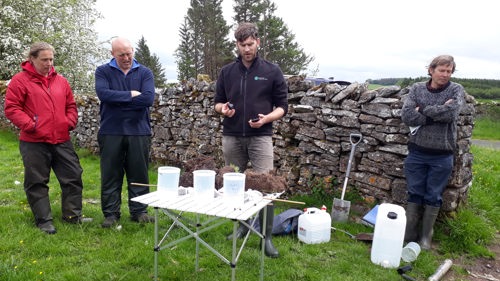





Seven farms in the Westmorland Dales were supported to develop a 'toolkit' of the most practical, useful indicators of soil health in northern upland farming. The cluster worked with advisors to implement changes to management practices which can be monitored using the toolkit.
This field lab brought together farmers, conservationists and researchers to collectively define what soil health means in the Westmorland Dales area.
Having a pool of researchers will enable the farmers to pull on a wide array of knowledge and as the research team we will be able to leverage student time to support with the project development.
Farmers in this field lab will test and compare a range of methods to measure soil health. These will range from simple visual observations and counts (at no cost to farmers) through to more technical measures of soil chemistry, biology and greenhouse gases.
They will then develop a toolkit of chosen measures that allow for meaningful, cost-effective monitoring and work with local conservationists on improvements to their management practices.
Assessments will include:
• Soil organic matter
• Carbon fractionation (which tells you about the stability of the carbon in the soil)
• Nutrients
• Soil structure
• Infiltration
• Soil loss
• Biodiversity measures (such as earthworms, micro-inverts)
The group will look to link these with measures of plant growth/nutrition including productivity and forage quality.
The group met at the end of April to discuss the results from soil tests analysed by a research student (Finley) at Lancaster University. Working under supervision of Dr Rachel Marshall, he carried out a variety of tests (including soil organic matter (SOM), pH, bulk density and infiltration rates) across a range of differently managed grassland and silage fields across the cluster.
Seventeen fields were chosen across the cluster with the aim of getting a range of management types defined by an intensity scale developed by Finley.
Finley found that SOM varied across the different management types with higher content in the less intensively managed fields. There was a lot of variation in SOM within fields that were less intensively managed reflecting the fact that these fields were more variable in character compared to silage fields (which are generally more homogeneous).

All fields had relatively high SOM and were in the normal range for the soil type and area. pH increased with more intensive management. Infiltration rates were measured at one point in each field and a general trend of decreasing infiltration rate was observed as management became more intensive although more sampling would be required to be able to see if trends were significant.
The results were interesting as they showed that there were substantial differences in soil characteristics across the cluster but it was hard to see clear trends due to the underlying differences in landscape type and underlying geology. In the next stage of the work the cluster will look at making comparisons between pairs of fields that are relatively close to each other but differ in land management. The research team and an RSPB advisor are supporting with field choices.
The seven triallists, part of the Orton Fells Farm Cluster cover a mixture of livestock, dairy, arable, including some intensive production. The group are interested in practical ways to monitor and improve soil health in the landscape of the North West of England.
The group met in June with researchers from CEH and an advisor from Cumbria Wildlife Trust. We looked at soil samples from two neighbouring fields which had been managed differently. One was a regenerated hay meadow; the other had been managed with slurry and fertiliser applications albeit minimal. The researchers introduced us to various assessments, including:
• Visual: The soil from the hay meadow was darker which indicates higher organic matter, and, in turn would indicate more carbon. The soil from the hay meadow also showed a different rooting structure.
• Smell: Both soils smelled sweet, indicating healthy soil
• Infiltration rate (how easily water/rainfall soaks into soils): Both soils showed similar results which is in line with the fact that there had been little or no compaction. Visually, the hay meadow appeared to have a higher soil moisture content and held more water. This will be key attribute in supporting water management in the changing weather and flash flooding experienced in the area.
Soil aggregation: Soil was placed in a small bag and shaken to show how quickly the soil broke up and dispersed out of the bag. Both soils showed good aggregation and there were few differences between the two.
For comparison we also looked at farm woodland soil which was darkest in colour. We also introduced the potential to use a Nix colour checker (https://www.nixsensor.com) as a potential tool for determining soil colour. This offers a route for cheap estimation of soil carbon content and might be an interesting tool to test on soils across the farms in the cluster.

If you like to try out some of the different measurements we demonstrated in the field, see the following advice and guidance:
Visual assessment of soil structure
Soil mentor - this describes a number of different soil tests
October 2020
January 2021
February 2021
June 2021
July 2021
September 2021
January 2024

Chapel Farm
Jane lives and farms in Norfolk with her husband and three sons. She leads the family farm in Cumbria, and sits on Cumbria CLA (Country Landowners Association) Committee and is a Trustee on the CLA Charitable Trust.

University of Lancaster
Lancaster
